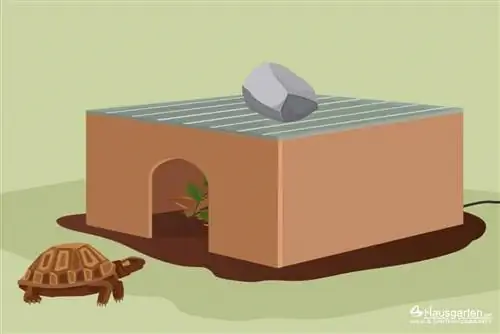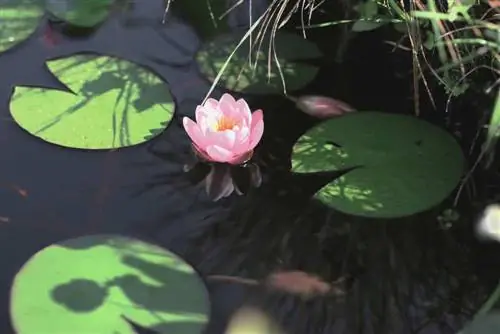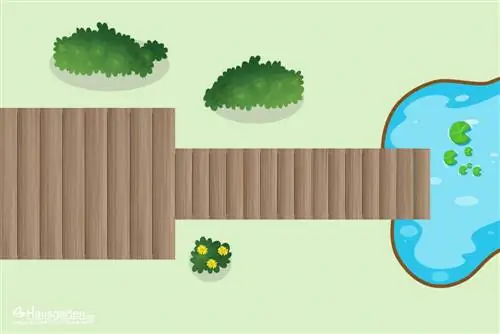- Author admin [email protected].
- Public 2023-12-17 03:39.
- Last modified 2025-01-24 12:45.
Without a doubt, the garden pond is a visual highlight in every garden. Whether as a place to stay for koi carp or on a larger scale as a swimming pond: a garden pond enriches a garden immensely and is a very special highlight.
Basic information about building a pond filter yourself
In order to keep the garden pond attractive in the long term, it is essential that it undergoes regular care. The most important element for proper care is the pond filter, which ensures good water quality and clear water. However, purchasing a high-performance pond filter involves considerable costs. This is why many garden owners shy away from maintaining their own garden pond.
A good alternative to a commercial pond filter is the self-constructed variant of a pond filter. This allows you to save a large part of the purchase costs for a commercial pond filter. For example, with a so-called barrel filter, which is a widespread variant among self-made pond filters. This has already been used thousands of times and has proven itself again and again due to its high reliability in terms of excellent water quality.
In principle, when building a pond filter yourself, it must be individually tailored to each garden pond. Various parameters play a crucial role here. For example, it must be taken into account which substances and in what quantities have to be filtered out of the water by the filter. If a garden pond is designed for keeping fish, it contains different substances than, for example, a so-called swimming pond. A pure plant pond has completely different ingredients that need to be filtered out.
Other important parameters when designing a pond filter are the respective pond volume and the flow rate through the individual filter elements. If the speed is not planned correctly and the water stays in the filter for too short a time, it cannot completely absorb and filter out the substances. In general, a good pond filter should be completely filled with the amount of water contained in the pond within an hour.
Required materials and general information
The following construction instructions give tips for implementing a pond filter, which has a filter volume of around 100 liters and is suitable for a garden pond with a water volume of ten to twenty thousand liters of water. To build the pond filter, 5 rain barrels with a volume of 200 liters are required. Furthermore, various HT pipes and HT elbows, various rubber seals and brushes are used. For the actual filtering process in the pond filter, coarse and fine filter mats are used, as well as lava granules, bas alt or gravel.
The actual pond filter consists of five different stages. Each of the five required barrels forms a step, with the water being fed into each of the water barrels from above. The water then flows from top to bottom in the self-made pond filter, then back up again, before flowing into the next one of the five tons in the next step. After flowing through the fifth and final barrel, the filtered water is then returned to the garden pond.
- HT pipes are used to connect the individual barrels to each other; appropriate cutouts must be created for their insertion into the barrels.
- The cutouts should be placed as close as possible under the edge of the barrel and then provided with rubber seals.
- The individual pipe sections are then pulled in as connections, with a barrel spacing of 5 cm each having an optimal effect on the later functionality of the pond filter.
- The individual connecting pieces are then placed inside the barrel with an elbow of 45 to 75 degrees, a pipe extension to the barrel base and a final elbow.
- In the first barrel, the pond is connected to the pond pump via a hose connection, with the UVC filter required to disinfect the water being placed in between.
- When setting up the barrels, make sure that they have a slight slope to each other, with the filter level below being lower than the previous one.
Structure of the five filter stages
The first of the five tons does not contain any filter materials, as this is only intended to set the pond water to be filtered in motion. However, even here, coarse dirt particles settle on the bottom of the barrel. The second bin must be filled with brushes, which must stand vertically in the bin. There are so many brushes to use that they can get stuck inside the bin without additional fasteners. In this filter stage, coarse particles are also retained during the water flow.
The third of the five tons must be provided with coarse filter mats. These are placed in a vertical position inside the bin. To fix the filter material, spacers are required, which can consist of strips of shredded, coarse filter mats. In principle, the mats can also be placed close to each other in the bin. However, there is a risk that the pond filter will become clogged too quickly. More frequent cleaning of this filter stage would then be the immediate consequence.
Granules - such as lava granules - are used to fill the fourth barrel. Bas alt rocks or gravel stones can also be used. It is important to ensure that the individual stones do not have a diameter larger than 1 to 2 cm. A higher grain size would have a negative impact on the later functionality of the pond filter. The fifth and final filter stage is then equipped with fine filter mats. These must also be reinstalled in a vertical position and provided with spacers. This is the only way to counteract the previously described effect of this filter stage becoming clogged too quickly.
What you should know about building your own pond filter in brief
- Pond filters consist of mechanical and biological filtering.
- A pre-filter acts as a mechanical part. It removes coarse dirt from the water.
- In the biological part, ammonia, nitrite and nitrate are converted and broken down.
- A chemical step can also be installed to bind phosphates.
There are two options for building your own pond filter, one is the filtered version and the other is the gravity version. In the first variant, a pump transports the water into the filter. The second variant allows the water to enter the filter by gravity. The water is pumped back into the pond by a pump behind the filter.
- Pumped pond filters are placed above the water level to prevent the water from running back.
- Gravity pond filters are located below the water level to allow water to flow back.
The pond filter should be placed in a shady location so that the water in the containers does not heat up excessively. When building a pond filter system, the timing should also be considered, as algae formation begins in spring. If the pond filter is switched on in time, algae formation can be prevented.






